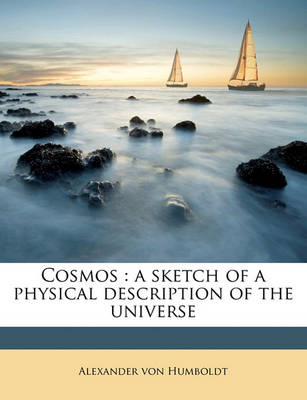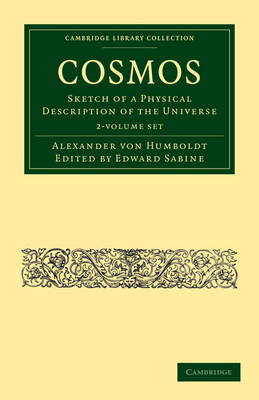Cambridge Library Collection - Physical Sciences
1 primary work • 4 total works
Volume 1
The first volume of 'Cosmos', his five-volume survey of the universe, appeared in 1845, though Humboldt had labored on the entire work for nearly half a century. He scrupulously sent sections of the work to other experts for suggestions and corrections. The last volume, put together from his notes after his death, appeared in 1861. The volumes were translated almost as rapidly as they appeared. This paperback edition reprints the Harper & Brothers edition, published in New York in 1858-59.
Polymath Alexander von Humboldt (1769-1859), a self-described 'scientific traveller', was one of the most respected scientists of his time. Humboldt's wanderlust led him across Europe and to South America, Mexico, the U.S. and Russia, and his voyages and observations resulted in the discovery of many species previously unknown to Europeans. Originating as lectures delivered in Berlin and Paris (1827-1828), his two-volume Cosmos: Sketch of a Physical Description of the Universe (1845-1860) represented the culmination of his lifelong interest in understanding the physical world. As Humboldt writes, 'I ever desired to discern physical phenomena in their widest mutual connection, and to comprehend Nature as a whole, animated and moved by inward forces'. Volume 2 (1848) reviews poetic descriptions of nature as well as landscape painting from antiquity through to modernity, before using the same time-span to examine a 'History of the Physical Contemplation of the Universe'.
Polymath Alexander von Humboldt (1769–1859), a self-described 'scientific traveller', was one of the most respected scientists of his time. Humboldt's wanderlust led him across Europe and to South America, Mexico, the U.S., and Russia, and his voyages and observations resulted in the discovery of many species previously unknown to Europeans. Originating as lectures delivered in Berlin and Paris (1827–1828), his multi-volume Cosmos: Sketch of a Physical Description of the Universe (1845–1860) represented the culmination of his lifelong interest in understanding the physical world. As Humboldt writes, 'I ever desired to discern physical phenomena in their widest mutual connection, and to comprehend Nature as a whole, animated and moved by inward forces.' Volume 1 (1846) investigates celestial and terrestrial phenomena, from nebulae to the temperature of the earth, as well as 'organic life'. Throughout, he stresses the method of, and limits to, describing the universe's physical nature.
Polymath Alexander von Humboldt (1769-1859), a self-described 'scientific traveller', was one of the most respected scientists of his time. Humboldt's wanderlust led him across Europe and to South America, Mexico, the U.S. and Russia, and his voyages and observations resulted in the discovery of many species previously unknown to Europeans. Originating as lectures delivered in Berlin and Paris (1827-1828), his two-volume Cosmos: Sketch of a Physical Description of the Universe (1845-1860) represented the culmination of his lifelong interest in understanding the physical world. As Humboldt writes, 'I ever desired to discern physical phenomena in their widest mutual connection, and to comprehend Nature as a whole, animated and moved by inward forces'. Volume 1 explains celestial and terrestrial phenomena, while Volume 2, demonstrating Humboldt's interest in representations of the natural world, examines poetic descriptions of nature, landscape painting, and how the physical universe was comprehended through history.



